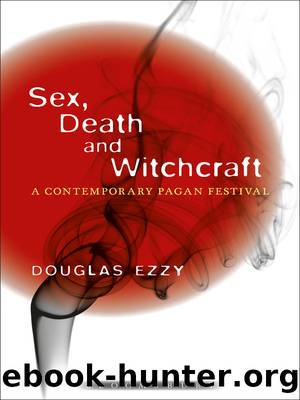Sex, Death and Witchcraft by Douglas Ezzy

Author:Douglas Ezzy
Language: eng
Format: epub
ISBN: 9781472533630
Publisher: Bloomsbury UK
Published: 2014-10-14T16:00:00+00:00
CHAPTER FIVE
Baphomet
A Witchesâ Sabbat
Male and female witches met at night, generally in solitary places, in fields or on mountains. Sometimes, having anointed their bodies, they flew, arriving astride poles or broom sticks; sometimes they arrived on the backs of animals, or transformed into animals themselves. Those who came for the first time had to renounce the Christian faith, desecrate the sacrament and offer homage to the devil, who was present in human or (most often) animal or semi-animal form. There would follow banquets, dancing, sexual orgies. Before returning home the female and male witches received evil ointments made from childrenâs fat and other ingredients. (Ginsburg 1992: 1)
The Baphomet ritual performed at Faunalia is inspired by a desire to reclaim, and re-Paganize, the myth of the Witchesâ sabbat described by the early modern Christians. Drawing on historical accounts, the organizers recreate a contemporary Pagan version of the ritual. The idea has similarities to Margaret Murrayâs (1921) thesis that the Christian inquisitors discovered an ancient fertility religion. According to Murray, contemporary Witchcraft is a direct descendent of this ancient religion. Carlo Ginsburg (1992) presents a subtler version of the thesis. He argues that European shamanistic folk practices were reinterpreted by Christian inquisitors as evidence of the existence of a Witchesâ sabbat. Ginsburg contends that it is implausible that the elements of the Witchesâ sabbat described in the trials were entirely an invention of the inquisitorsâ imaginations. Although the Witchesâ sabbats were a fantasy, he suggests that they were based on a systematic Christian misinterpretation and diabolistic reinterpretation of a pre-existing set of folk beliefs and practices. Silverblatt (1983) presents a parallel argument that Spanish colonizers of the Andes sought to reinterpret indigenous culture as Witchcraft and Satanic. While there has been considerable academic criticism of Murrayâs work, and to a lesser extent Ginsburgâs, the idea that the Witchesâ sabbat describes an ancient Pagan religious practice is taken up in a number of texts on contemporary Paganism, the most notable being the influential work of Starhawk (1979).
A quotation in the Introduction describes Harrisonâs motivations for creating the Baphomet rite. It is worth quoting again:
Harrison: I wanted to create a rite that would challenge peopleâs prejudices. There was a certain element of shit stirring and iconoclasm. At first it was going to be a mere Pagan revel with just a few elements drawn from the [medieval Witchesâ] sabbat. It would be evocative and Pagan and ecstatic. A lot of modern Paganism in my opinion is way too sanitized and inoffensive and not challenging to the status quo. I wanted to have an experience that was an emotional experience, that was moving and wonderful and magical. I got some ideas from the legend [of the Witchesâ sabbat. I said to myself] I will use that bit, but not that bit.
Where the Christian inquisitors sought moral self-development through the repression of the body and its pleasures, participants at Faunalia seek moral self-development through the celebration of the body and its pleasures. The Baphomet rite challenges the fear of these aspects of what it is to be human.
Download
This site does not store any files on its server. We only index and link to content provided by other sites. Please contact the content providers to delete copyright contents if any and email us, we'll remove relevant links or contents immediately.
Tools of Titans by Timothy Ferriss(7822)
Crystal Healing for Women by Mariah K. Lyons(7715)
The Witchcraft of Salem Village by Shirley Jackson(7042)
Inner Engineering: A Yogi's Guide to Joy by Sadhguru(6446)
The Four Agreements by Don Miguel Ruiz(6324)
The Power of Now: A Guide to Spiritual Enlightenment by Eckhart Tolle(5344)
Secrets of Antigravity Propulsion: Tesla, UFOs, and Classified Aerospace Technology by Ph.D. Paul A. Laviolette(5002)
The Wisdom of Sundays by Oprah Winfrey(4954)
Room 212 by Kate Stewart(4741)
Pale Blue Dot by Carl Sagan(4626)
Fear by Osho(4496)
The David Icke Guide to the Global Conspiracy (and how to end it) by David Icke(4386)
Rising Strong by Brene Brown(4195)
Animal Frequency by Melissa Alvarez(4156)
How to Change Your Mind by Michael Pollan(4115)
Sigil Witchery by Laura Tempest Zakroff(4033)
Real Magic by Dean Radin PhD(3928)
The Art of Happiness by The Dalai Lama(3851)
Man and His Symbols by Carl Gustav Jung(3847)
